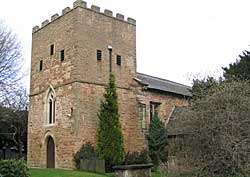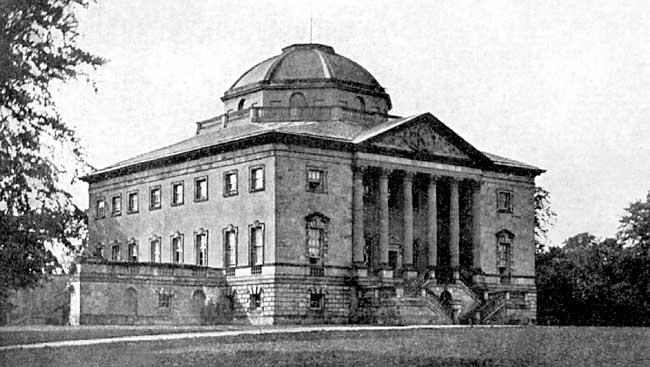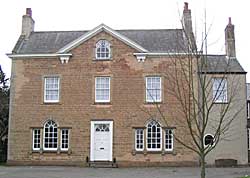Nuthall from the 16th century to modern times

St Patrick's church, Nuthall (photo: A Nicholson, 2004).
UNDER its Ayscough owners Nuthall passed from one branch of the family to another and some of it was sold to freeholders. The. manor was purchased by James Ayscough, a merchant of London, who in 1616 was granted a court leet with all its rights. As patron of the living he presented to it in 1612 Edward Greaves, who is worthy of notice as a benefactor to the parish of St. Peter's at Nottingham, and also as the father of the supposed author of the valuable description of Nottingham in 1641—Deering's "Anonymous Author"—which may have been written here.
James Ayscough died in 1625, and having directed that the manor be sold, a third part of it passed to Edward Ayscough who became, deeply involved in the Civil War. As a captain of Meldrum's horse he greatly distinguished himself at Gainsborough and afterwards at the last siege of Newark and occupied several important offices in the county under the Commonwealth. Yet this did not prevent his daughter from marrying John Digby who was one of the leading local cavaliers, and John Hill, the rector who fought for King Charles, may have served under Digby's command. When the war was over he returned to his cure, and in 1650 was a "preaching minister," but it is improbable that he was permitted to remain.
Religious Census.
The Restoration found Robt. Horne occupying the rectory which he allowed to fall into disrepair. By 1664 he had been ejected, but he presently conformed and for the rest of his life was rector of West Hallam. By 1677 two-thirds of the manor, with the patronage of the living, had passed to the Slaters, and the parson, who was also curate of Basford, reported that there were 142 adult residents in the parish, no popish recusants, but two persons resolutely abstained from attending the church services as by law ordained. Two generations later, in 1743, there were 64 orthodox families with one of Anabaptists and one of Quakers. The rector was also curate at Hucknall and resided at Linby, but he maintained a curate here to whom he allowed £15 a year and surplice fees, and divine service was held once a Sunday alternately, in the morning and afternoon.
Through lack of heirs male the manor descended by heiresses from the Rd. Slater of Thoroton's time (1677) to the Sedleys. One of the Slater heiresses married George Pole, and it was their granddaughter who in 1718 brought it by marriage to Sir Charles Sedley. The dissolute courtier-poet of that name, to whose company Charles II was partial, was of this family and was connected with the Saviles of Rufford, but was not otherwise associated with the shire.
A Curious Bequest.
One curious local will has been mentioned, and in 1744 Rd. Smedley added another when, in addition to providing maintenance in his almshouses at Ilkeston for one poor person of Nuthall for ever, he left £5 a year for the education of phildren of this parish who were old enough to play at battledore. The first Sir Charles was content to reside in the old Nut Hall, but his successor in 1754 pulled that down and commenced the erection of the "Temple" on an adjoining site. He and his Stapleford friend, Borlase Warren, were the mainstays of the fashionable races at Nottingham, and the story goes that it was his winnings on the turf that defrayed the cost of the princely dwelling which was completed in 1757. He died in 1778, having served in three Parliaments as one of the Members for Nottingham, and as once again a son was lacking, the property devolved upon an heiress.His daughter brought it by marriage to the Hon. Henry Vernon, second son of Lord Vernon, who assumed the name of Sedley, but abandoned it upon succeeding to his father's title and estates.
The Sedleys were responsible for much tree planting: in 1798 the estate included some 113a of woods. They may have enclosed the manorial open-fields and wastes, but the date, of enclosure is unknown. In 1758 the upper stage of the church tower was built, and two years later the tumble-down old parsonage gave way to a new rectory-house. A colliery is said to have been working there on the south side of the park, and stocking-frames were introduced into the village, but the principal local pits, at Awsworth, Shilo, and Cinderhill (all in this civil parish} are of subsequent date, the last-named opening in 1842.
In 1844, when a shoemaker named Robinson was the parish clerk, a grocer named Pendleton was the parish road-surveyor: how astonished this worthy would be at the sight of the metalled modern highways and in particular the 50ft. wide Nottingham-Newhaven road that has replaced the miry narrow lane at which he no doubt tinkered !
The "Temple."

Nuthall Temple, c.1905.
In 1799 the "Temple" was described as "the elegant seat of Henry Sedley, Esquire, with woody scenery to the right and left," for he or his forbears had transformed the large bare paddock into a timbered park and made the beautiful lake worthy of the stately house. In 1819 he sold it all to his friend Robert Holden of Darley Abbey and a family tradition states that the sale was made through a misapprehension on the part of his London solicitor, without, however, disturbing the good relations between the friends. Under the Holdens the "Temple" and its environments were further improved. The village prospered too, but it received a shock in 1832, when the bill for the destruction of Nottingham Castle by the rioters of the previous year came in.
The Castle stood within the Hundred of Broxtowe; the whole of the Hundred had to pay the £21,000 awarded to the Duke of Newcastle for its destruction and of this sum Nuthall's share was £401, an amount necessitating a heavy rate and inflicting hardship upon the innocent inhabitants.
A century ago the "Temple" was occuped by Thomas Nixon, but it soon reverted to its owner, Col. Robt. Holden, who became widely known for his benevolence. A room in the mansion was set apart as the central office for his system of private outdoor relief, a work to which he gave unremitting personal attention until his death in 1871, when most of Nuthall was inherited by his brother, the Rev. A. A. Holden.
A Venerable Yew.

The Old Rectory, Nuthall.
The most venerable object in the village is probably the fine yew tree in the churchyard for which the clergyman-owner claimed the by no means impossible age of a thousand years and which may well be more ancient than the oldest part of the church. The church itself is one of the extremely few medieval foundations dedicated to St. Patrick and is the sole example in the county. Repaired in 1838, re-roofed 20 years later, and finely restored in 1884, it is a typical specimen of an old country church and it has happily preserved many of its interesting old features.
On the outer face of the south wall of the chancel the remains of a low-side window may be seen, but whatever its purpose was it certainly had no connection with lepers, as is commonly believed. The north pier of the chancel arch displays a hagioscope, or squint, that lighted the altar in St. Mary's chapel where a piscina exists. Another piscina in the chancel stands low through the raising of the floor. Two windows have old armorial glass, and a two-light square-headed window is of a fashion much favoured in the district about 1400 and rarely found elsewhere.
Stretton described the church in 1819 as cold and damp, painted white inside, with "pews old and of oak," a pulpit of the same material, and "a plain oak table" for its high altar. Lord Vernon's pew, "very chaste and rich;" then occupied the chapel in the aisle, but in 1884 its carved oak, which may originally nave formed the roodscreen, was cleverly used to make the present screens. After four and a half centuries the tower arch has become distorted by settlement, and the chancel is out of alignment with the nave. As is usual in such instances it bears to the north and it is thought that this symbolises the drooping of the Saviour's head upon the Cross.
Part of the old parish is now included in Kimberley, and in 1877, Giltbrook and Gilthill were officially transferred to Greasley, Hempshill coming into the civil parish. Nottingham's attempt to incorporate Nuthall in 1919, was defeated. But in 1927, the "Temple " with its estate of 600 acres was sold, and more recently, the mansion has been destroyed.
